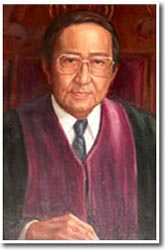Claudio Teehankee
The Honorable Claudio Teehankee Sr. | |
|---|---|
| 郑建祥 | |
 | |
| 16th Chief Justice of the Philippines | |
| In office April 2, 1987 – April 18, 1988 | |
| Nominated by | Corazon Aquino |
| Preceded by | Ramon Aquino |
| Succeeded by | Pedro Yap |
| 82nd Associate Justice of the Supreme Court of the Philippines | |
| In office December 17, 1969 – April 1, 1987 | |
| Nominated by | Ferdinand E. Marcos |
| Preceded by | Eugenio Angeles |
| Succeeded by | Andres Narvasa |
| Secretary of Justice | |
| In office August 5, 1967 – December 16, 1969 | |
| President | Ferdinand E. Marcos |
| Preceded by | Jose Yulo |
| Succeeded by | Juan Ponce Enrile |
| Personal details | |
| Born | Claudio Sangroniz Teehankee April 18, 1918 Manila, Philippine Islands |
| Died | November 27, 1989 (aged 71) New York City, New York, U.S. |
| Resting place | Libingan ng mga Bayani |
| Nationality | Filipino |
| Children | 9, including Claudio Teehankee Jr. |
| Alma mater | Ateneo de Manila University |
Claudio Sangroniz Teehankee Sr., CCLH, KGCR (Tagalog: [si]; Chinese: 郑建祥; pinyin: Zhèng Jiànxiáng; April 18, 1918 – November 27, 1989) was the 16th Chief Justice of the Supreme Court of the Philippines from 1987 to 1988.
He was also the most senior associate justice and chairman of the First Division of the Supreme Court of the Philippines.
Personal life[]
Teehankee was born on April 18, 1918 in Manila, Philippines.
His father, José Tee Han Kee (simplified Chinese: 郑汉淇; traditional Chinese: 鄭漢淇; pinyin: Zhèng Hànqí; Pe̍h-ōe-jī: Tīⁿ Hàn-kî), immigrated to the Philippines in 1901 from Fujian province in China. He was a close associate and friend of Sun Yat-Sen, and was active in the struggle to liberate China from the Qing dynasty.[1] He was also the first director of the Chinese General Hospital.[2] He married Julia Ong Sangroniz, a fellow Chinese-Filipino with a naturalized Filipino surname, and had eight children, with whom Teehankee was to be the seventh child in a conservative Chinese enclave in Manila. His other siblings were Jose, Alberto, Luis, Gloria (Nenita), Rafael (Piling), Eligio (Ador) and Horacio.[3]
Teehankee was married to Pilar D. Javier with whom he had nine children. He received his high school degree in 1934, his A.B. degree, finishing summa cum laude in 1938, and LL.B. summa cum laude in 1940 from the Ateneo de Manila, making him the only person to receive the honor. He also garnered first place when the law school was in its early years in the 1940 bar examination with an average of 94.35 percent.
He became Secretary of Justice under the Marcos administration in 1967 before being appointed as associate justice in 1968. His son Claudio Jr. though would be imprisoned for homicide in the early 1990s. The death penalty was reinstated because of concurrent debates after reactions to the public sentence were mixed.
Accomplishments[]
This section does not cite any sources. (March 2018) |
He was known as the court's "activist" justice because of his dissenting opinions in many vital cases affecting the Marcos administration. He was the lone dissenter in many cases, such as the High Tribunal's decision upholding the constitutionality of the Judiciary Reorganization Act of 1980. He also dissented in policies which would seem to curtail the basic liberties of people. For a time, Teehankee and Justice Cecilia Muñoz-Palma would dissent together. After Muñoz-Palma's retirement, he was joined by Associate Justice Vicente Abad Santos in dissenting.
It was this activism that made Marcos 'by-pass' him twice for the position of Chief Justice (the most senior associate justice is most likely to succeed after the retirement of the Chief Justice) in 1985. It was after the removal of Marcos that he was appointed Chief Justice by Corazon Aquino in 1987.
Later years and death[]

After his retirement, he was appointed as the Philippine Ambassador to the United Nations, where he died of cancer in Manhattan, New York on November 27, 1989.
Legacy[]
As a former Chief Justice, Teehankee Sr. is interred at the Libingan ng mga Bayani in Taguig.
In recognition of his courage in upholding the rule of law during the Marcos dictatorship, Teehankee Sr. was honored by having his name etched on the Wall of Remembrance of the Philippines' Bantayog ng mga Bayani in Quezon City, which honors the Martyrs and Heroes who defied Marcos' authoritarian rule.[4]
See also[]
- Chief Justice of the Supreme Court of the Philippines
- Associate Justice of the Supreme Court of the Philippines
- Supreme Court of the Philippines
- Constitution of the Philippines
References[]
- ^ Tan, Antonio S. (1972), The Chinese in the Philippines, 1898–1935: A Study of Their National Awakening, Manila: R.P. Garcia Publishing Co.
- ^ "Upcoming Events".
- ^ "Remembering Lolo Dingdong".
- ^ Contributor, Staff (July 13, 2016). "Heroes and Martyrs: TEEHANKEE, Claudio". Bantayog ng mga Bayani. Retrieved August 27, 2021.
Further reading[]
Cruz, Isagani A. (2000). "Res Gestae: A Brief History of the Supreme Court". Rex Book Store, Manila
Sources[]
- 1918 births
- 1989 deaths
- 20th-century Filipino lawyers
- Associate Justices of the Supreme Court of the Philippines
- Ateneo de Manila University alumni
- Burials at the Libingan ng mga Bayani
- Deaths from cancer in New York (state)
- Centro Escolar University alumni
- Chief Justices of the Supreme Court of the Philippines
- People from Manila
- Secretaries of Justice of the Philippines
- Marcos Administration cabinet members
- Filipino politicians of Chinese descent
- Individuals honored at the Bantayog ng mga Bayani
- Judges and justices honored at the Bantayog ng mga Bayani
- Permanent Representatives of the Philippines to the United Nations
